Folk Dances
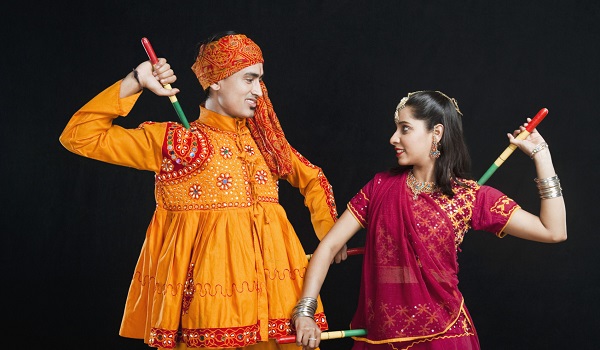
Image Source: http://swadesh.unnatisilks.com
India is a land of varied cultures and traditions. Diversities in all spheres make the Indian culture quite unique. Indian folk and tribal dances are product of different socio-economic set up and traditions evolved over ages. In India, we have festivals and celebrations virtually every day, and dances are performed to express joy and festivity. This has added to the richness of Indian culture. Since every festival is accompanied by celebration, folk dances have become an integral part of our social milieu. There are numerous folk and tribal dances, and almost all of them have continuously evolved and improvised.
Folk dances are performed for every possible occasion - to celebrate the arrival of seasons, birth of a child, a wedding and festivals, which are a plenty. The folk dances are extremely simple with minimum of steps or movement. Indian folk dances are full of energy and vitality. Some dances are performed separately by men and women while in some performances men and women dance together. On most occasions, the dancers sing themselves, accompanied by artists with instruments. Each form of folk dance has a specific costume and rhythm. Most of the costumes, worn for folk dances, are colorful with extensive jewels and designs. Let’s have a look at folk dances of India.
North India
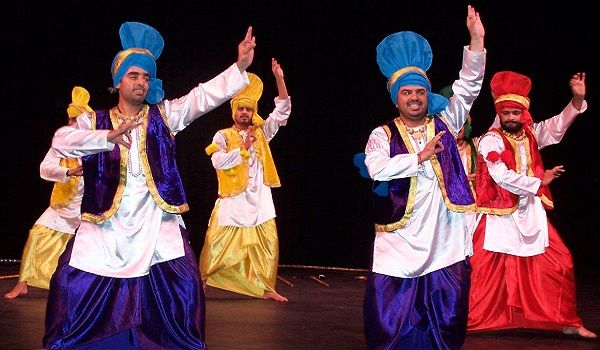
Image Source: www.kreativeduniya.com
- Dumhal -This age-old dance is still kept alive by the Rauf tribe of Jammu & Kashmir and is performed by men who wear long and colorful robes, accompanied by tall conical caps. The performers place a banner into the ground at a fixed location, and the dance is performed around this banner.
- Hikat - Performed in groups, the dancers hold each other’s hand and go around dancing in circles. The pace of their movement is adjusted according to the tempo of the music being played. Usually, it all begins slowly and the pace gradually picks up until the women gain full momentum.
- HurkaBaul - This dance form is associated with the state of Uttarakhand. Performed during maize and paddy cultivation in the state, this dance form is more of a storytelling. While a singer incorporates heroic stories of battles in his song, the dancers enact the stories with the help of their moves.
- Chholiya - ‘Chholiya’ dance form is practiced in the Kumaon region in the state of Uttarakhand. It is traditionally performed in wedding processions. Sword wielding men dancers are seen dancing spiritedly and hence ‘Chholiya’ is often referred as ‘sword dance’.
- Bhangra - ‘Bhangra’ is one of the most popular and energetic dances of Punjab. The origins of this impressive dance form remains speculative. While it is widely believed that ‘Bhangra’ is a martial dance form, it is also said that it was started by farmers to celebrate the harvest season. No celebration in the Punjab and surround areas is complete without a Bhangra performance.
- Dhamyal - ‘Dhamyal’ or ‘Dhuph’ is one of the most popular folk dances of Haryana. ‘Dhuph’ is a circular drum and is played by male dancers. The dance is performed as a part of celebration after a long day’s work in the fields.
- Mayur Nritya - This dance form is prevalent in the state of Uttar Pradesh. Also known as peacock dance, ‘Mayur Nritya’ is performed by dancers who wear specially designed clothes so as to resemble a peacock. It is performed while worshipping Lord Krishna.
- Charkula - It is a dance performed in the Braj region of Uttar Pradesh. ‘Charkula’ is basically a multi-tiered circular pyramid and it’s believed that Goddess Radha’s grandmother announced the birth of her granddaughter while balancing a ‘Charkula’ on her head. Hence women dancers carry huge ‘Charkulas’ which in turn holds many lighted oil lamps.
- Rasa Lila - It is a divine form of dance performed in several parts of India. This particular dance form is considered very important by the devotees of Krishna as it has a mythological significance. It is believed that the dance was performed by Krishna along with Radha and her friends.
- Giddha - This dance form is performed in the state of Punjab. Giddha is the female version of ‘Bhangra’. The dance aims at expressing the feminine grace. The women wear colorful clothes while performing. Giddha is usually accompanied by ‘Bolliyan’, a collection of couplets.
Central India
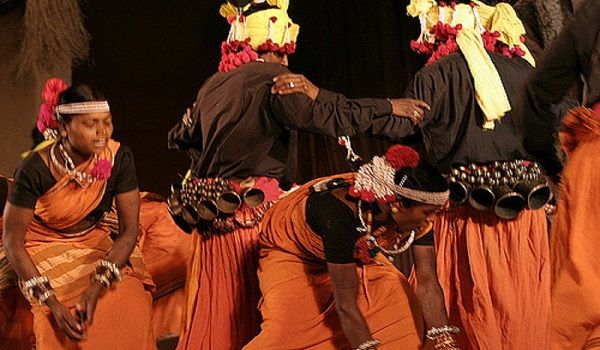
Image Source: bastarcg.in
- Gaur Dance - This dance is associated with the tribal people in the state of Chhattisgarh. In this dance, men don colorful head-dresses and hats adorned with peacock plumes. Women, beautified by tattoos and ornamented with fillets made out of brass and necklaces made out of beads, also join the gathering.
- Muria Dance - This dance is associated with the tribal people of the Bastar district of Chhattisgarh. It usually begins with an invocation to the phallic deity of the tribe. The Muria people also perform ‘Hulki’ dance and ‘Karsana’ dance. While ‘Hulki’ dance is considered the most attractive of all dance forms, ‘Karsana’ is seen as a recreational activity.
- Saila Dance - This dance form is associated with Bastar district in the state of Chhattisgarh. Saila is a unique dance in which the dancers use sticks for rhythmic purpose. The dancers are seldom seen forming a circle, each standing on one leg and supporting themselves by holding on to the dancer in front. Then they all hop together round and round.
- Karma Dance - Karma dance is performed by the tribes of Chhattisgarh, Jharkhand, Madhya Pradesh, Orissa, Bihar and other regions of India. The dance is associated with the fertility cult and is related to the Karma festival that falls in the month of August. The dancers form a circle by placing their arms on the waist of the adjacent dancer and dance in a rhythmic manner.
- Kaksar Dance- Kaksar dance is popular among the Abhujmarias of Bastar. It is performed in hope of reaping a rich harvest. To invoke the blessings of the deity, young boys and girls perform Kaksar. An interesting trivia about the Kaksar dance is that it allows its dancers to choose their life partners from the same dance troupe.
- Jhumar - This dance form originated in the Multan and Balochistan region of Pakistan. Jhumar is slower and more rhythmic. Often performed by men, ‘Jhumar’ marks the beginning of the harvest season and portrays the happiness of people.
- Jawara Dance - It is associated with the state of Madhya Pradesh. The dance not only involves rapid feet movement but also difficult acts of balancing. The women perform a balancing act by carrying a basket full of the harvested crop on their head.
- Bhagoria Dance - This is performed by the tribal people of Madhya Pradesh. Though the dance is part of a unique festival, which allows young men and women to elope, it has its own agricultural significance – completion of the harvest season.
- Suwa Dance - It is performed by tribes in the state of Chhattisgarh. Also known as ‘parrot dance’, this unique dance gets women to act like parrots! It is usually performed only by women and girls while men get to play musical instruments of their choice.
- Tertali Dance - It is performed by the Kamar tribe of Chhattisgarh. The dance is performed only by women who start by squatting. A musical instrument called ‘Manjira’ is tied all over their body – most commonly to their legs and the same is played by the performers throughout the ritual.
- Grida Dance - Grida dance is performed in the state of Madhya Pradesh during winter when the rabi crop is ready to be harvested. The dance marks the success of farmers which is celebrated among the villagers in a grand manner.
East India
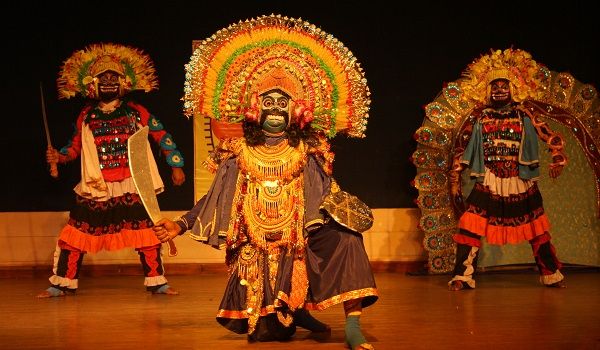
Image Source: http://armchairlounge.com
- Chhau - This dance form traces its roots to Odisha, Jharkhand and West Bengal but it is popular in other parts as well. As masks form an important feature of this dance it is called ‘Chhau’, which literally translates to ‘mask’. The performers wield weapons such as swords and shields while dancing.
- Brita Dance -‘Brita’ or ‘Vrita’ dance is one of the most prominent dances of West Bengal. The dance is usually performed to thank the local deity after recovering from a contagious disease – usually small pox.
- Dalkhai - This dance is popular in parts of Odisha. The dance is performed by young women who are later joined by men, playing drums and other instruments. Interestingly, the men address the women as their girlfriends throughout the play.
- Gotipua - It is performed in the parts of Odisha. 'Gotipua' is a unique dance form since the performers are dressed as women. The dance form is taken seriously by the boys so much so that they don’t cut their hair just to look like women.
- Bardo Chham - It is performed by Sherdukpens, a small community living in the West Kameng District of Arunachal Pradesh. The Sherdukpen tribe believe that every month an evil force appear to mar the good qualities of humans. Thus to ward off those evil forces, they wear masks representing different animals and dance together.
North East India
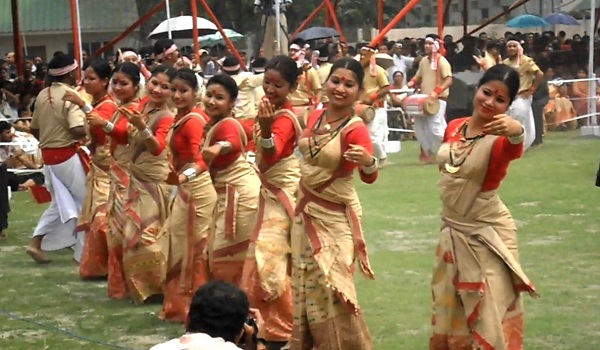
Image Source: YouTube.com
- Bihu - This dance form forms the most attractive part of the Bihu festival celebrated by the people of Assam. Bihu is celebrated at the beginning of the harvest season and goes on for nearly 30 days.
- Hojagiri - This dance is performed in the state of Tripura. Women and young girls balance bottle and earthen lamps on their head and move their lower body so as to make sure the bottles or lamps don’t fall. Men are involved in the act by singing and playing musical instruments.
- Nongkram Dance - Performed by the Jaintia Hill inhabitants of Meghalaya, the ‘Nongkram’ dance is a colorful event. The dance form is a way of paying respect to the local deity.
- Bagurumba - It is performed mainly by the Bodo tribe in Assam. Usually performed by the women, the dance is accompanied by instruments like drums and flutes. Bagurumba dance has a rich history and is believed to be inspired by nature.
- Bhortal Dance - It is a folk dance of Assam. Performers wield cymbals and dance in groups, with each group consisting of six or seven dancers. Dancers come up with a unique beat known as ‘7hiya Nom’ and engage in rapid feet movements.
- Jhumur - This dance is performed in the states of Assam, Jharkhand, West Bengal, and Odisha. The dance is performed by young girls while men take care of the musical part. The dancers place their arms around the waist of the adjacent dancer and sway to and fro in a synchronized manner.
- Cheraw Dance - It is performed in the Indian state of Mizoram. While the men move horizontally and vertically held bamboo staves, women dance in between them so as to avoid their legs getting caught in between the staves. The beats are formulated when the bamboo staves are moved at rapid pace.
- Chang Lo - This dance is performed by Chang tribe of Nagaland. Since the dance is traditionally performed to celebrate the victory over their enemies on a battle field, dancers don costumes worn by warriors and display war tactics in the form of dance.
South India
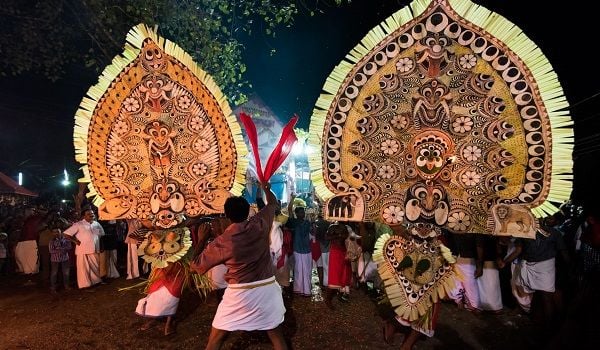
Image Source: ravikanthkurma.files.wordpress.com
- Padayani - It is performed in the central part of Kerala. Padayani is not only popular but is also pleasing to the eyes as colors form an important aspect of the dance. The dancers wear massive masks which often represent deities.
- Kummi - ‘Kummi’ is a popular folk dance in Tamil Nadu and Kerala. Since this dance form originated when there were no musical instruments, it just involves women singing and clapping.
- Kolannalu - It is performed in the state of Andhra Pradesh. Popularly known as the ‘stick dance’, ‘Kolannalu’ involves group of dancers forming two circles. While the inner circle receives a strike on their sticks, the dancers forming the outer circle deliver the strike.
- Parai Attam - It is a special type of dance in Tamil Nadu. Men folk play a percussion instrument called ‘Parai’ and dance to the rhythm they come up with. Traditionally, the dance was performed for various reasons and is one of the oldest dance forms of India.
- Karagattam - It is an ancient folk dance of Tamil Nadu. Karagattam is performed while worshipping the goddess of rain. Dancers balance huge pots on their head and dance to the tunes of musicians.
- Mayil Attam - It is performed in the temples of Tamil Nadu and kerala. This dance is similar to the ‘Mayur Nritya’ of Uttar Pradesh. Young girls are dressed to look like peacocks and perform to the beats of the musicians. The dancers often imitate the moves of peacock.
- Paampu Attam - It is performed in Tamil Nadu. This dance is performed while worshipping snakes as snakes are considered divine in this part of the country. Young girls wear clothes that resemble the skin of snakes and go about moving like snakes!
- Poikal Kudirai Attam - ‘PoikalKudirai’ literally means ‘horse with fake legs’. The dancers are made to look like they are riding a horse with just two legs! This is one of the most popular folk dances in Tamil Nadu.
- Theyyam - It is performed in the Malabar region of kerala. Theyyam is an age-old dance, performed to praise Goddess Kali and hence it is also known as ‘Kaliyattam.’ The dancers paint their faces with vibrant colors which add to the overall effect.
South West India
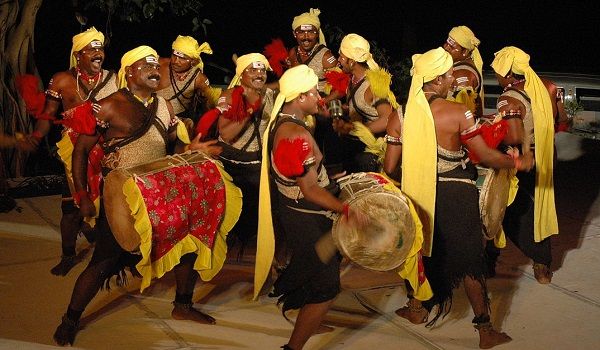
Image Source: Wikipedia.org
- Dollu Kunitha - It is performed in the state of Karnataka. Dollu Kunitha is a popular drum dance. Large drums are hung around the necks of men. The songs used in this dance usually have religious and battle fervor.
- Ghodemodni - It is performed in the state of Goa and the adjoining areas. Ghodemodni is also called as ‘warrior dance’as the performers are dressed as warriors and wield swords. The dance portrays a war since the village in which the dance form originated was once captured by a king.
- Lava Dance - This art form is performed in one of the islands of Lakshadweep. It’s performed by the men inhabiting the island. The dance is based on folk songs and rhythmic movements.
- Fugdi - It is a Goan dance performed in the Konkan region. Performed by women, this dance form is given life during Hindu festivals.The dancers make different formations like circles or rows and go about singing and dancing. The dance begins slowly and gains pace gradually.
- Veeragase - Veeragase is one of the prominent dances of Karnataka as it’s performed during Dasara celebrations in Mysore. Performed only by men, this dance form is intense and involves energy-sapping movements.
West India
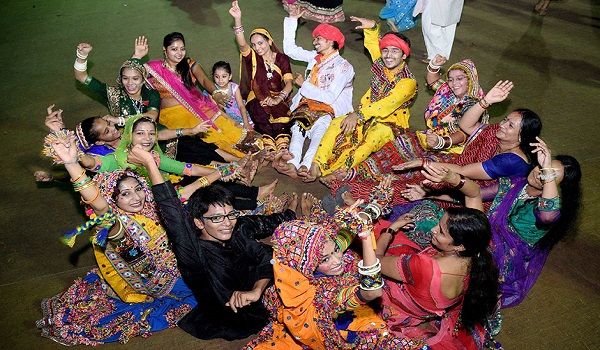
Image Source: firstpost.com
- Dandiya - This is very popular dance form in the states of Gujarat and Rajasthan. Dandiya is a dance form which requires its dancers to wield sticks and wear colorful costumes. Much like the ‘Saila’ dance, sticks here are used for rhythmic purpose.
- Garba - This dance form originated in the state of Gujarat. Garba is traditionally performed during the nine-day Hindu festival ‘Navaratri’. The dance is performed around a lamp. Often the lamp is replaced with a picture or statue of Goddess ‘Shakti’.
- Koli - Koli is performed in Maharashtra. Since the dance is performed by fishermen, it involves elements of fishing and sea. Both men and women are involved in this interesting dance form which is a treat to watch.
- Tippani Dance - Performed during weddings and festivals in Saurashtra region of Maharashtra, this dance is performed only by women. Shehnai and percussions like Manjira, Tabla and Dhol are used to create music.
- Padhar Dance - It is a folk dance performed in Gujarat. Performed by fishermen, who spend their lives along the banks of Nal Sarovar, Padhar dance involves enactment of fishing and rowing of boats.
State-wise distribution of Folk Dances
Arunachal Pradesh: Bardo Chham
Assam: Bagurumba, Bhortal, Jhumur, Khel, Gopal, Rakhal Lila, Tabal Chongli, Canoe, Nongkrem, Ankiya Nat, Kirtania Natak, Ojapali,Bihu
Bihar: Jadur, Kathaputli, Bhako, Jhijiya, Karma, Jatra, Natna, Bidesia, Senkela Chhau, Jat-Jatni Bidpada, Ramkhelia.
Chhattisgarh: Raut Nacha,
Gujarat: Dandiya, Bhavai, Garba, Tippani Dance, Padhar dance, Dangi Nritya, Hudo, Matukdi, Aagwa, Siddi Dhamal
Haryana: Swang, Naqqal, Ras Leela, Dhamal dance, Manjira dance, Dhamal dance, Goga dance
Himachal Pradesh: Nati, Kariyala, Bhagat, Ras Ihanld, Harnatra Haran or Harin.
Jammu and Kashmir: Bhand Pathar or Bhand lashna, Rouff, Vetal Dhamali.
Karnataka: Yakshagana, Bedara Vesha, Dollu Kunitha, Santa, Doddata-Bayalata, Tala Maddle or Prasang. Dasarata, Radhna.,veeragase
Kerala: Duffmuttu, Oppana, Padayani, Theyam, Kodiyattam, Margam Kali, Puli Kali, Mudiattam, Thirayattam, Chavittu Nadakam, titambhu nritam, Chakyar koothu,
Madhya Pradesh: Maanch, Nacha, Phul patti, Tertali, Grida
Maharashtra: Tarfa Naach, Tamasha, Lalit Bharud, Gondha, Dashavatar, Lavani, Koli dance.
Meghalaya: Shad sukmysiem, Shad nongkrem, Derogata, Do dru Sua, Laho
Nagaland: Chang Lo (Sua Lua)
Odisha: Pala Jtra, Daskathia, Mayurbhanj Chhau, Mangal Ras, Sowang, sambalpuri (dalkhai, rasarkeli), parbha
Punjab: Naqqal, Swang Bhangra .
Rajasthan: Khyal, Rasdhari, Rammat, Turra Kilangi, Gauri, Ghoomar, Nautanki, Ihamtara.
Andhra Pradesh: Veethi Natakam, Burrakatha, Lambadi, Koya.
Tamil Nadu: Therukuttu, Veethi Natakam, Bhagwat Mela Natakam, Kurvaanji, Pagal Vasham, Kavadi Chindu.
Telangana: Bathukamma
Uttar Pradesh: Bhagat, Sang-Swang, Naqqual, Mayur Nritya, Charukala
Uttrakhand: Chholiya
Goa: Fugadi, Dashavatar, Perni jagar, Musal khel, Samai nrutya, Gonph dance, Dekhni, Kunbi dance, Ghode modni, Dhalo, Tonya mel, Talgadi
West Bengal: Chhau (Purulia), Santhali



